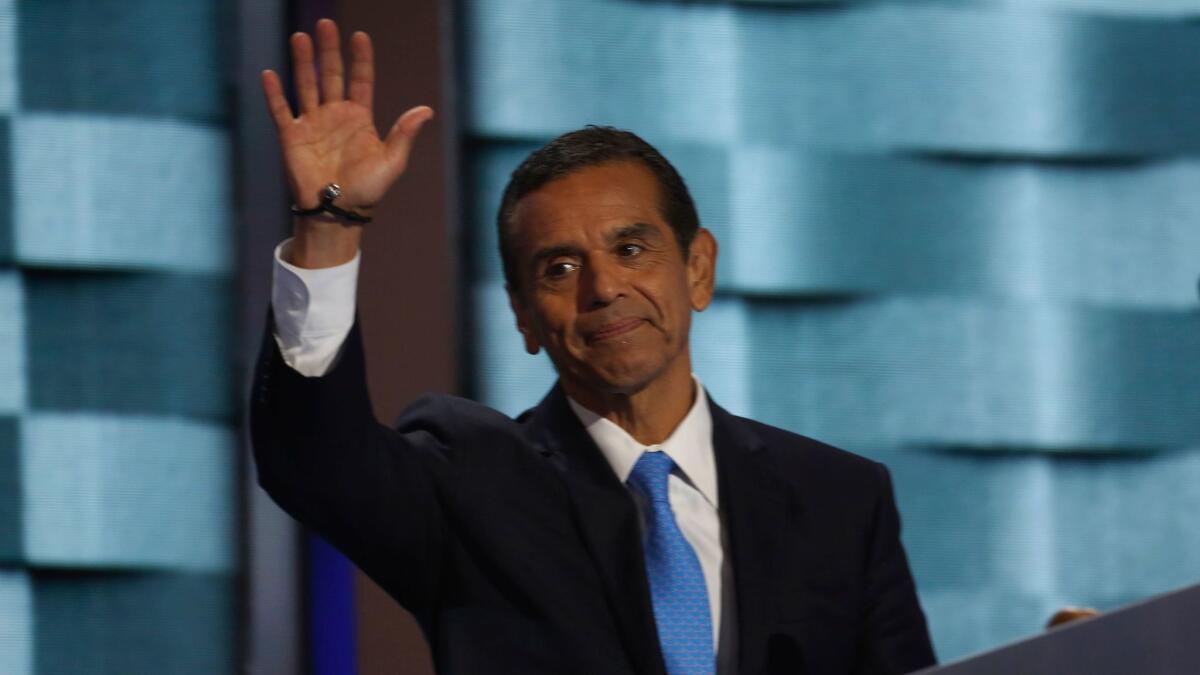Capitol Journal: Villaraigosa says he wants to be a uniter as he runs for governor

Reporting from Sacramento — With the ugly presidential race now history, the next major political contest in California has officially begun. It’s to replace Gov. Jerry Brown.
Brown — the longest-serving California governor ever — can’t run for reelection in 2018 because of term limits. He’ll be finishing his fourth. The limit is two. But his first two were freebies in the 1970s before Californians imposed term limits.
Who should replace Brown is a crucial question. Who is most capable of fixing California’s nagging problems of water shortage, highway deterioration, regulatory quagmires, underperforming schools, outdated taxes and public pension debt?
And who can mimic Brown in keeping the state’s day-to-day spending in check?
Here’s an ironclad guarantee: Based on the current field of governor wannabes, the contest will be relatively civil compared to the presidential horror show. Kids can be allowed to watch.
Another fairly sure bet: The winner will again be a Democrat. More than 3 million Californians did vote for Republican Donald Trump. But nearly twice as many sided with Democrat Hillary Clinton.
The candidacy filing deadline for governor won’t come until early 2018. But the probable field was pretty much set last week when former Los Angeles Mayor Antonio Villaraigosa, 63, officially entered the contest.
Three other Democrats already were in the race: Lt. Gov. Gavin Newsom, 49, state Treasurer John Chiang, 54, and — a distant long shot — former state schools chief Delaine Eastin, 69.
“Villaraigosa is a fierce campaigner, and if he can raise the dough, he’s someone to be reckoned with,” says Democratic strategist Steve Maviglio, a former gubernatorial and legislative advisor.
True. As the state Assembly speaker from 1998 to 2000, Villaraigosa was a tenacious, hard-charging deal maker who tended to get things done. He also was charismatic, with a quick smile.
He didn’t come out charging in his campaign kickoff, however. He said all the right things, practically singing “Kumbaya” in an effort to attract the favorable attention of voters shocked by the presidential mud wrestle.
“I truly believe that what people are looking for is a uniter,” Villaraigosa told me, echoing a favorite word of former Republican President George W. Bush. “Particularly now after such a divisive campaign.”
When I asked the former mayor why he’d be a better choice for voters than Newsom or Chiang, he wouldn’t bite. “I’m not going to focus on any other candidates,” he replied.
“I’m not going to throw kerosene. I’m going to be a uniter. But I’ll fight and stand up for values where I must. I’m a uniter but a fighter too.”
OK. We’ll see how all that plays out when the campaign gets hot.
Villaraigosa’s other main pitch was one that Democrats don’t use enough: “I want to help rebuild the middle class by investing in our schools and repairing our state’s infrastructure.”
The high school dropout — who later graduated from UCLA — indisputably holds credentials as an education reformer. He hasn’t always been successful, but his push for charter schools has angered teachers unions.
“Middle class starts with education,” he says. That includes training for the new economy and also for skilled service jobs, he adds.
All the upbeat talk is easy, of course. But once a candidate wins and attains power, decisions must be made that please some and anger others. Some interests benefit financially, others lose.
“I know that far better than most,” Villaraigosa says. “I was mayor during the recession and had to make tough calls. But I left with a high approval rating.”
What about Brown’s two cherished legacy projects: The $64-billion bullet train from L.A. to San Francisco and the $15.5-billion twin tunnels siphoning fresh water from the Sacramento-San Joaquin River Delta?
“The short answer is I’m for the train,” he says. “But we need to drive down the cost. We need to leverage it for economic development and jobs. That’s what I did with light rail.”
But leveraging the bullet train for economic development in the middle of San Joaquin Valley cotton fields and nut orchards doesn’t compare with laying light rail in a big city.
“Before we build those tunnels,” Villaraigosa continues, “we’ve got to do a lot more in cities. Double recycling, go to drought-tolerant plants, clean up aquifers and invest in underground storage.”
And, he adds, build two long-promised dams — one off-stream in the Sacramento Valley and another above Fresno on the San Joaquin River.
“We spend too much time finger-pointing and not cooperating,” says Villaraigosa, who has spent many days in San Joaquin Valley farm communities listening to gripes about the drought.
“There are shantytowns growing near Firebaugh and Huron because of the water crisis,” he says.
Villaraigosa clearly sees not only L.A. County, but the Latino-heavy San Joaquin Valley as sources of voter strength.
He’d be California’s first Latino governor since 1875. No L.A. mayor has ever been elected governor. Maybe that means the odds for one are getting better.
This is shaping up as a hot contest between two former mayors: Villaraigosa and Newsom of San Francisco.
“Newsom could charm birds out of a tree,” says Democratic consultant David Townsend, who has been a volunteer advisor to Chiang.
Chiang expects to be heavily supported by Asian voters. But they represent just 10% of the electorate. He’ll also need to attract Republicans and the business community.
This race could get wild. But it will be civilized.
Follow @LATimesSkelton on Twitter
ALSO
Antonio Villaraigosa jumps into the California governor’s race
California’s next governor: Who’s running, who’s on the fence?
Watch Villaraigosa speak at the Democratic National Convention
More to Read
Get the L.A. Times Politics newsletter
Deeply reported insights into legislation, politics and policy from Sacramento, Washington and beyond. In your inbox three times per week.
You may occasionally receive promotional content from the Los Angeles Times.











